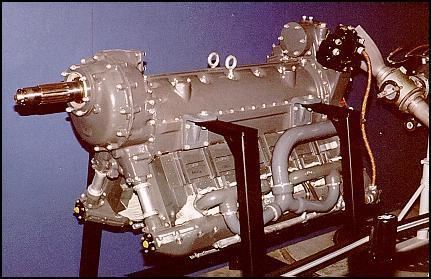The Ranger V-770 was an American air-cooled inverted V-12 aero-engine developed by the Ranger Aircraft Engine Division of the Fairchild Engine & Aircraft Corporation in the early 1930s.
Design and development
In 1931, the V-770 design was put to paper, based on the Ranger 6-440 series of inverted inline air-cooled engines, and test flown in the Vought XSO2U-1 Scout. In 1938 it was tested in the Curtiss SO3C Seamew and found to be unreliable with a tendency to overheat in low-speed flight. By 1941 a more developed V-770 was installed in the Fairchild XAT-14 Gunner prototype and was used in the production Fairchild AT-21 Gunner gunnery school aircraft.
Produced from 1941 to 1945, the V-770 featured a two-piece aluminum alloy crankcase, steel barreled cylinders with integral aluminum alloy fins and aluminum alloy heads. The V-770 was the only American inverted V12-type inline air-cooled engine to reach production. The engine was used in very few Army Air Forces aircraft, among them the short lived Fairchild AT-21 twin-engine bomber trainer, and in the two Bell XP-77 light-weight fighter prototypes.
V-770-4Installed in the
Vought XSO2U-1 scout aircraft
V-770-6Installed in the Fairchild XAT-14 Gunner prototype, intended for the Ryan SOR-1 Scout
V-770-7Installed in the
Bell XP-77 light-weight fighter prototype
V-770-8Installed in the
Curtiss SO3C Seamew Scout.
V-770-9Installed in the North American XAT-6E Texan prototype.
V-770-11Installed in the Fairchild AT-21 Gunner.
V-770-15Installed in the Fairchild AT-21 Gunner.
SGV-770C-1Tested in the Curtiss XF6C-7 Hawk Fighter-Bomber at 350 hp.
SGV-770C-B1Installed in the
Ikarus 214 prototype
SGV-770D-5Developed for post-war commercial use, 700 hp (kW) at 3,600 RPM, weight 870 lb (395 kg), height 31.11 in (790 mm), length 74.92 in (1,900 mm), width 33.28 in (846 mm)
Bell XP-77Curtiss SO3CEdo OSEFairchild F-46 (Duramold)Fairchild AT-21Fairchild BQ-3Ikarus 212Ikarus 213 / Utva 213 Vihor / Government Factories Type 213 VihorIkarus 214 (prototype)Vought XSO2UData from Janes Fighting Aircraft of World War II (1989)
Type: 12-cylinder inverted Vee piston engineBore: 4 in (101.6 mm)Stroke: 5 1⁄8 in (130.2 mm)Displacement: 773 in3 (12.6 L)Length: 62 in (1,574.8 mm)Width: 28 in (711.2 mm)Height: 32.2 in (817.88 mm)Dry weight: 730 lb (331 kg)Valvetrain: Single overhead camshaft (SOHC) (1 shaft per bank), gear drivenSupercharger: Single-Speed, Single-Stage, produced 45 inches of mercury (1.5 bar, 7.5 psi) at take-offFuel system: Holley non-icing carburetorFuel type: 87 octane petrolOil system: Full pressure typeCooling system: Air-cooledPower output: 520 hp at 3,150 rpm (387.7 kW)Specific power: 0.673 hp/in3Compression ratio: 6.5:1Power-to-weight ratio: 0.71 hp/lbCarolinas Aviation Museum 1 restored engine in storage2 engines in the Davis Aircraft private collection*One survives at Cincinnati State Aviation schoolOne V770-7 is at the Museum of Flight restoration center.
